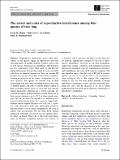The extent and costs of reproductive interference among four species of true bug
Abstract
Reproductive interference arises when individuals of one species engage in reproductive activities with individuals of another, leading to fitness costs in one or both species. Reproductive interference (RI) therefore has two components. First, there must be mis-directed mating interactions. Second, there must be costs associated with these mis-directed interactions. Here we consider RI between four species of true bug in the family Lygaeidae, focusing in particular on the fitness consequences to Lygaeus equestris. The species we consider vary in their relationships with each other, including species in the same or different genus, and with or without natural overlap in their geographic ranges. First we show that inter-specific mating interactions, although not a certain outcome, are common enough to perhaps influence mating behaviour in these species (arising in up to 10 % of inter-specific pairings). Second, we show that reproductive interference can seriously reduce female fitness in L. equestris. Importantly, different species impose different costs of RI on L. equestris, with interactions with male Spilostethus pandurus inflicting fitness costs of similar magnitude to the costs of mating with con-specifics. On the other hand, mating interactions with male Oncopeltus fasciatus appear to have no effect on female fitness. In a follow-up experiment, when we allowed competition amongst just females of S. pandurus and L. equestris, the fitness of the latter was not reduced, arguing more strongly for the role of reproductive interference. However, in our final experiments under mass mating conditions with extended ecological interactions (including scope for competition for resources and cannibalism), the costs of RI were less apparent. Our data therefore suggest that the costs of RI will be context-specific and may act in concert with, or be swamped by, other ecological effects. We suggest that comparative studies of this sort that both mimic naturally occurring reproductive interference events, and also artificially generate new ones, will be necessary if we are to better understand the ecological and evolutionary significance of reproductive interference.
Citation
Shuker , D M , Currie , N , Hoole , T & Burdfield-Steel , E R 2015 , ' The extent and costs of reproductive interference among four species of true bug ' , Population Ecology , vol. 57 , no. 2 , pp. 321-331 . https://doi.org/10.1007/s10144-014-0470-1
Publication
Population Ecology
Status
Peer reviewed
ISSN
1438-3896Type
Journal article
Description
ERB-S is supported by a Natural Environment Research Council (NERC) studentship and DMS was in part supported by a NERC Advanced Fellowship.Collections
Items in the St Andrews Research Repository are protected by copyright, with all rights reserved, unless otherwise indicated.

